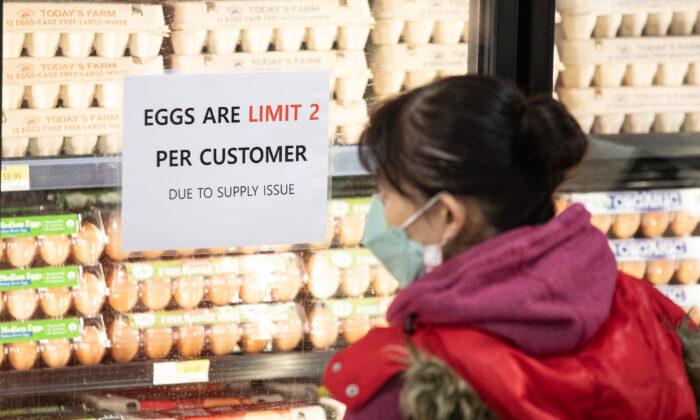That omelet has become expensive. Buying anything with eggs in it is a considerable monetary investment. So egg prices have been increasing, but chicken prices have remained the same or, in some areas, are decreasing.
Eggs, which have always been a low-cost way to eat protein, are expensive. But why are they so pricey, and why is chicken holding its own? The economy is one reason, but it’s not the only thing.
Eggs Surge in One Year
Many Americans eat eggs as a primary protein substitute. And those that don’t, still like a few eggs with their bacon. But eggs are beyond what’s on the breakfast table. They’re in many foods we eat. From baked goods to salad dressings, eggs are everywhere.The price of eggs has risen steadily in the last year. In December’s Consumer Price Index, eggs had increased 59.9 percent year over year.
As of January 2023, the average dozen eggs in California cost $7.37. On the East Coast, South Carolina saw eggs ring in at $4.65 for a dozen.
Some consumers are finding it hard even to find eggs, as many grocery stores have empty bins in their refrigerator section. And some stores limit how many cartons a customer can buy at a time.
This surge in egg prices has caused other price increases. For example, mayonnaise has risen in cost by 18.2 percent since last year.
Disease Strikes Egg Layers
The main culprit for egg prices and scarcity is avian flu. Bird flu, as it is known, is caused by avian influenza type A viruses. Waterfowl and other wild birds spread it. This mainly occurs during migratory times. And it hasn’t been this deadly since 2016.The infected wild birds, who don’t show symptoms, fly over a flock of domestic birds like chickens or turkeys. The infected birds’ droppings and nasal discharge contaminate dust and soil. This infects the domestic birds living in it.
The strain that has hit the United States is Eurasian H5N1. It is considered highly pathogenic. It aggressively goes through a flock.
It infects the chicken’s respiratory and gastrointestinal tracts. Some symptoms include:
- swelling
- gasping for air
- lack of appetite
- nasal discharge
- lethargy
- stumbling
- reduced egg production
Sometimes a hen will die without showing any symptoms.
The first commercial case was confirmed in February 2022 by the U.S. Department of Agriculture. Since the first case, 57.8 million egg-laying hens, broiler chickens, and turkeys have been killed by the virus or euthanized by the farmers. Infected birds are euthanized to stop the infection’s spread through a flock.
How to Contain Bird Flu
Since it only takes one contact with the flu virus to kill chickens, biosecurity must be adhered to stop the spread. This includes disinfecting shoes, clothes, crates, tires, equipment, etc., before bringing them onto the chicken farm.Sick birds must be euthanized immediately to avoid spread.
Is Bird Flu Contagious to Humans?
There is little risk to humans. Human cases are extremely rare. During this latest outbreak, only one person tested positive.Infected birds are not allowed to enter the nation’s food chain. If one gets through, cooking the chicken to 165 degrees Fahrenheit will kill any virus.
Broilers Minimally Affected by Flu
You may have noticed that chicken prices are holding steady or slightly dropping. That’s because “broilers,” the birds bred for consumption, haven’t been affected by the avian flu. Instead, the “layers” seem to be the ones targeted.Layers and broilers are different bird types. For example, the life cycle of a broiler is five to nine weeks from hatch to slaughter. A layer’s life is upwards of 100 weeks. It takes six months to reach full productivity. This gives them more of an opportunity to be infected by the bird flu.
Inflation Kicks in With Egg Prices
Inflation is also a factor that has elevated egg prices. Commodities like corn and soybeans are primary ingredients in chicken feed. These commodities’ prices have steadily risen over the last year. Part of this increase is due to rising fuel costs. When there are eggs, the cost of food distribution has also increased.When Will Egg Costs Decrease?
Overall, the national wholesale price for a dozen eggs was $3.30, which is higher than January 2022’s $1.93. But the wholesale price was even higher at $3.59 in November 2022. So maybe there’s a possible downward turn. But even if the wholesale price does start to diminish, there will be a lag before it’s seen in the grocery store.Time to Build Up Flocks
Eggs may be pricey for a while longer. It will take time to build up the layer flocks, and farmers still have the high feed and fuel costs due to inflation to contend with. But building up the flocks is the key. It takes time for a chick to mature into an egg layer.The Epoch Times Copyright © 2022 The views and opinions expressed are those of the authors. They are meant for general informational purposes only and should not be construed or interpreted as a recommendation or solicitation. The Epoch Times does not provide investment, tax, legal, financial planning, estate planning, or any other personal finance advice. The Epoch Times holds no liability for the accuracy or timeliness of the information provided.






